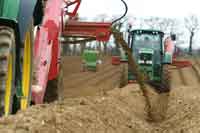Potato processor wages war on waste

Inefficiencies in the potato supply chain mean almost half the tubers grown for a retail crop won’t make it to the consumer, an industry research project has found.
The War on Waste project, carried out by processing firm Solanum, which supplies Waitrose, found that for every 1000t of potatoes produced for packing, just 583t made it to the customer.
That meant 42% of the crop was wasted through inefficiencies from the moment the crop was planted to the day it left the retail outlet, said Simon Bowen, the firm’s agronomy director.
Field losses through bruising, uneven tuber size and poor quality accounted for 6% of losses, while defects removed during grading, such as damaged tubers, greens and rots, totalled 12%, he told delegates.
Sprouting, disease and weight loss in the store made up 5% of rejections, but the biggest percentage was lost in the pack house, with 22% removed due to defects spotted after washing alone.
However, this figure might be lower for other retailers, as Waitrose demanded a high specification, he admitted.
Rejections from packing, distribution and the retail store was no more than 5% in total, he noted.
Retailers and the supply chains they support were coming under increasing scrutiny and food waste would have to be reduced, said Dr Bowen.
Planting crops in unsuitable soils was the biggest contributor to waste, followed by a lack of suitable irrigation and pest and disease management, the study found.
Size, shape, greens and damage were the main reasons for gross defects, and weight loss was the biggest contributor in-store. In the pack-house, greens, damage, scab and skin disease were the main culprits.
Although losses occurred at all levels of the supply chain, improving management of the crop in the field was the most important place to start, said Dr Bowen. “Quality is made in the field, not the pack-house.”
Solanum recently dropped to 30 of the best growers from a network of 130, to help meet its target of reducing waste to 35% by the end of the project in 2013, said Dr Bowen.
“This was a big rationalisation, but allowed us to work more closely with fewer growers and improve agronomy and efficiency.”
The firm is now helping these growers to cut waste by improving soil, water and seed management, and in 2009 they managed to reduce waste by 4%.
War on Waste is a five-year project which started in 2008 to assess the level of waste produced in the potato supply chain and come up with practical solutions to reduce it.
Conference bites
PVY concern
Levels of PVY infection in Scottish seed crops were expected to be high in 2011, meaning some seed crops could be downgraded, said Jon Pickup, head of virology and zoology for SASA.
Numbers of rose grain aphids – the main PVY vector – has been increasing steadily for the past three years, and SASA’s virus model predicted 32% of the 2011 crop would be infected with PVY. This level of infection meant 6-7% of the seed crop could be downgraded, he said.
It was already too late to protect this season’s crop, as virus would have already been transmitted, but growers should act now to protect next year’s crop, he warned.
Watching residues
Government monitoring of chemical residues in potatoes had found a number of active ingredients, including those that would not normally be expected, said John Sarup, senior potato consultant for SAC.
These included seed treatments pencycuron, iprodione and soil treatment axoxystrobin. Growers should be more careful when using chemical products at all stages of crop management to avoid contamination, he said. “If we are found to be using pesticides inappropriately, we will lose them.”
To plough or not to plough
Ploughing is energy intensive and time consuming and growers should consider if they need to do it, said Stuart Wale, team leader for SAC.
Almost all potato crops in the UK are established behind the plough, but other countries were successfully using non-inversion tillage, he said.
Power-harrowing ground without ploughing could halve fuel and labour costs and reduce erosion, he added.
Elephant in hiding
Elephant hide is a condition that causes a coarse russeting on tubers. It is not well understood and is difficult to diagnose, as the effect on tubers can vary, said SAC potato pathologist, Daan Kiezebrink. Elephant hide can be linked to rhizoctonia, in which case Amistar (azoxystrobin) could be an effective treatment. But there are other causes, too, he said.

